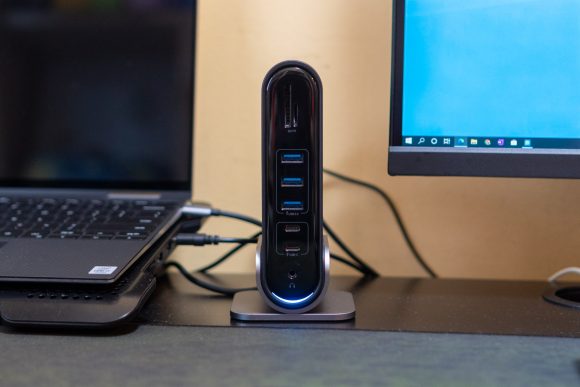
USB Type-C multifunction adapters are pretty common. Many people connect all their peripherals through one of them. Not surprising then, that there are some, like this good-looking Baseus 17-in-1 USB-C Hub, which are designed to work as a docking station for your notebook.
The idea behind notebook docking stations is simple. It’s a device you leave at your work desk, somewhat permanently connected to all the peripherals you’ll need, such as monitors, external storage, and network. You come in with your notebook, connect to the docking station, and you’re all setup to start work. No need to fiddle around with all the cable connections.
Long ago, however, docking stations were very proprietary, and each was designed to work with only a specific type of notebook from that one particular brand. Notebooks dock into them. Interface connection aside, the physical characteristics of the docking station makes it impossible to use for any other notebook.
USB Type-C, or USB-C, has changed all that. You connect with a, by now, fairly ubiquitous cable connection. Some manufacturers still call their devices hubs, because that’s what they really are, but they are equivalent to universal versions of docking stations from time past.
Baseus’ 17-in-1 USB-C hub is quite different from other USB-C multifunction adapters. It’s not just that it has more ports than most. It is designed to be left on your desk, connected to all the peripherals you need. You don’t have to, since it is still reasonably portable, though larger than most USB-C multifunction adapters.
You’ll be hard pressed to find a USB-C hub with more ports than this Baseus 17-in-1 USB-C Hub. On the front, starting from top to bottom, you have a SD card slot, microSD card slot, 3x USB 3.0 Type-A port, 3x USB 3.0 Type-C port, and a 3.5 mm audio combo jack.
You can only use either of the card slots (SD or microSD) at any one time, but it’s good that both sizes are supported.
On the back, there is one USB-C PD port for connecting a USB-C PD charger, a USB-C PD port for connecting to a computer, 2x USB 2.0 Type-A ports, 3x HDMI ports, a DC jack for powering the hub, and a Gigabit Ethernet RJ45 port. This hub supports up to 100 Watt of USB-C PD.
This hub can ordinarily be powered by the upstream computer. However, you may need to plug in a power supply to the DC jack if you plan to use all the ports, in case the computer can’t supply enough power. This is only for powering the hub, and the power adapter is an optional order.
It’s quite awesome to see so many HDMI ports on this Baseus 17-in-1 USB-C Hub. You can connect three external monitors in extended mode, though this only works in Windows. Unfortunately, with macOS, all the three ports will mirror each other, and together, they can either mirror or extend the built-in Mac display; you cannot have each external monitor display different contents from each other.
The highest resolution supported on the HDMI port is quite complicated to understand. At the minimum, 1080p is not a problem. You can get one 4K@60Hz output with macOS in SST mode, but only from one of two HDMI ports. In most other configurations, and with Windows, the best you can get is 4K@30Hz.
The restrictions in maximum display resolution isn’t got to do with this hub per se, but due to USB-C design limitations. I begun to learn all the complications surrounding USB Type-C and Thunderbolt 3 hubs recently, and the topic is complex enough to need a post (or more) of its own.
For my testing, I connected this hub to a QHD@60Hz monitor and a FHD@60Hz monitor. They work great.
The Baseus 17-in-1 USB-C Hub is particularly good-looking. In fact, I think I’ve yet to see any other hub that looks as pretty as this one. The build quality and finishing is excellent. It comes with a stand, which is a very exacting fit to the hub. The stand allows you to hold the hub vertically, reducing the space needed on your table.
You can also lay the hub flat down on the table if that’s what you prefer.
The box packaging containing the Baseus 17-in-1 USB-C Hub is pretty nicely designed. A USB-C to USB-C for connecting between the hub and notebook is included.
If you order the bundle with the power brick, you get three plug adapters for UK, EU, and US socket types.
Apart from the limitations surrounding 4K support, which isn’t a problem with the hub per se, the Baseus 17-in-1 USB-C Hub makes an excellent docking station even if you have rather demanding peripheral connection needs.
The Baseus 17-in-1 USB-C Hub retails on Lazada for around S$120 (without power brick) to S$130 (with power brick).
Summary
This is probably the best looking USB-C docking station out there, and a very capable one at that.
Pros:
- Excellent design and build quality
- Plenty of connections
- 3 HDMI outputs
Cons:
- Limitations in USB-C imposes restrictions on 4K output
